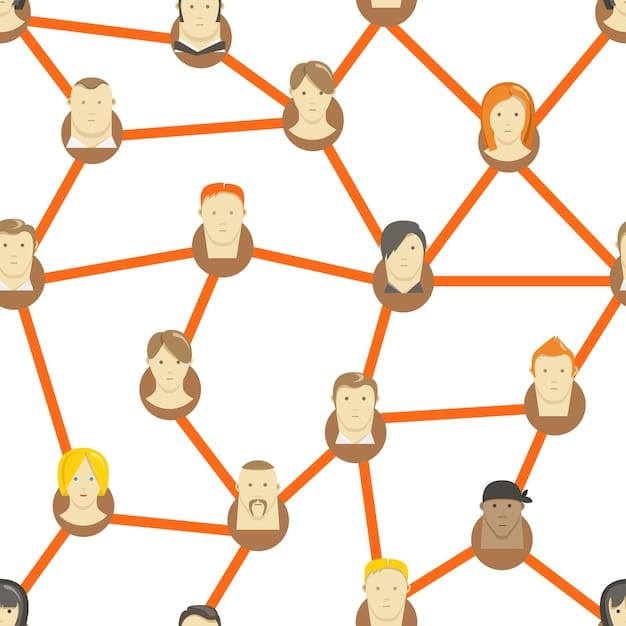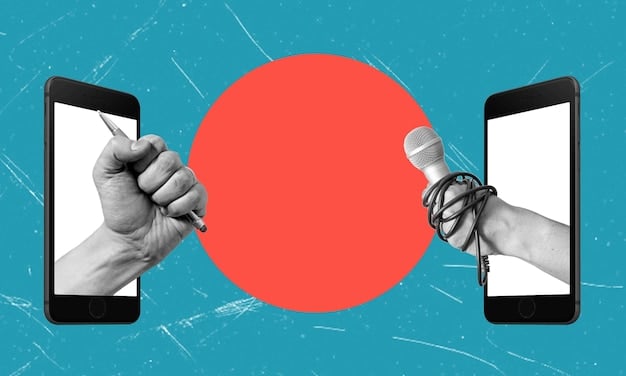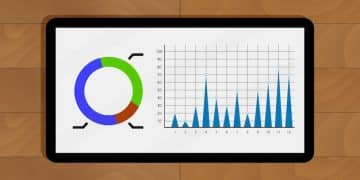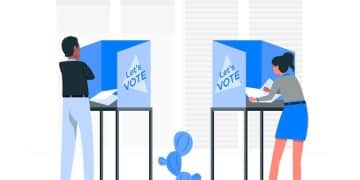Decoding Political Polarization: Data Analysis of Social Media Discourse

Decoding the Latest Trends in Political Polarization: A Data-Driven Analysis of Social Media Discourse involves examining how social media amplifies division, identifying key influencers, and understanding the role of algorithms in shaping political opinions and behaviors within online communities.
Political polarization is increasingly shaped by online interactions. Decoding the Latest Trends in Political Polarization: A Data-Driven Analysis of Social Media Discourse becomes crucial to understanding its impact.
Understanding the Shifting Landscape of Political Polarization
Political polarization, a phenomenon characterized by the divergence of political attitudes to ideological extremes, has become increasingly pronounced in recent years. This trend is significantly influenced by the digital realm, particularly social media platforms, where opinions are amplified and echo chambers can solidify pre-existing beliefs.
To truly grasp the multifaceted nature of this issue, it’s essential to delve into the data-driven analysis of social media discourse. This approach allows us to move beyond anecdotal observations and gain a more objective understanding of the dynamics at play. By examining patterns, trends, and key influencers, we can begin to decode the latest trends in political polarization.
The Role of Social Media Algorithms
Social media algorithms play a pivotal role in shaping the content users see, often prioritizing engagement over accuracy. This can lead to filter bubbles, where individuals are primarily exposed to information that confirms their existing beliefs.
Echo Chambers and Their Impact
Echo chambers, where users are primarily exposed to like-minded opinions, can reinforce and intensify political polarization. These environments limit exposure to diverse perspectives, hindering constructive dialogue and understanding.
- Algorithmic amplification of extreme views.
- Reinforcement of pre-existing biases through selective content exposure.
- Reduced exposure to opposing viewpoints, leading to increased polarization.
- Formation of strong in-group and out-group dynamics.
Analyzing social media data reveals how algorithms contribute to the formation and reinforcement of echo chambers, exacerbating political divides and limiting opportunities for meaningful cross-ideological engagement.

Data Collection and Analysis Methodologies
Decoding the intricacies of political polarization requires robust data collection and analysis methodologies. Researchers employ a variety of techniques to gather and interpret social media data, providing valuable insights into the dynamics of online political discourse.
These methodologies allow for a systematic examination of the language, topics, and networks that characterize political polarization on social media, enabling a deeper understanding of the underlying mechanisms driving division.
Sentiment Analysis Techniques
Sentiment analysis, using natural language processing, gauges the emotional tone of online political discourse. By identifying whether sentiments are positive, negative, or neutral, researchers can assess the overall emotional climate surrounding different political issues.
Network Analysis Approaches
Network analysis maps the relationships between individuals and groups on social media. By visualizing these networks, researchers can identify key influencers, echo chambers, and the flow of information within politically polarized communities.
- Identifying prominent figures and their impact on online discourse.
- Mapping the structure of polarized online communities.
- Tracking the spread of information and misinformation.
- Assessing the influence of bots and foreign interference.
Through careful data collection and rigorous analysis, researchers can provide valuable insights into the ways in which social media contributes to and reflects political polarization.
Identifying Key Influencers and Their Impact
In the vast landscape of social media, certain individuals wield significant influence over the political discourse. These key influencers, ranging from politicians and journalists to activists and celebrities, can shape public opinion and drive polarization.
Understanding the roles and impact of these influencers is crucial for anyone attempting to decode the trends in political polarization. Their online activities can either bridge divides or deepen them, depending on their messaging strategies and engagement tactics.
Analyzing Content and Messaging Strategies
Examining the content and messaging strategies employed by key influencers reveals how they frame political issues and appeal to specific audiences. This analysis can uncover patterns of persuasion, emotional appeals, and the spread of misinformation.
The Role of Amplification and Reach
Key influencers often have a large and engaged following, allowing them to amplify their messages and reach a broad audience. This amplification can significantly impact public opinion, particularly when messages are emotionally charged or divisive.

- Assessing the reach and impact of influencer content.
- Identifying patterns in messaging strategies.
- Evaluating the role of influencers in spreading misinformation.
- Analyzing the engagement and interaction of followers.
By identifying and analyzing the activities of key influencers, we can gain a deeper understanding of the dynamics of political polarization and the ways in which social media shapes public opinion.
The Spread of Misinformation and Disinformation
The proliferation of misinformation and disinformation on social media is a significant concern, as it erodes public trust, distorts perceptions of reality, and fuels political polarization. False or misleading information can spread rapidly through online networks, often amplified by algorithms and shared by unsuspecting users.
To combat this challenge, it’s essential to decode the mechanisms that enable the spread of misinformation and disinformation. Understanding how these narratives take hold and spread is crucial to mitigate their impact.
Identifying Sources of Misinformation
Tracing the origins of misinformation can help identify the sources responsible for creating and disseminating false or misleading information. This can include individuals, groups, or even state-sponsored actors seeking to manipulate public opinion.
The Role of Bots and Trolls
Bots and trolls can play a significant role in spreading misinformation and amplifying political polarization. These automated or malicious accounts can generate fake content, harass opposing viewpoints, and manipulate online discussions.
Combating misinformation requires a multi-faceted approach, including media literacy education, fact-checking initiatives, and platform accountability. By empowering individuals to critically evaluate information and holding social media companies responsible for the content shared on their platforms, we can mitigate the spread of false and misleading information.
Comparative Analysis Across Different Platforms
Political polarization manifests differently across various social media platforms, each with its unique user demographics, content formats, and algorithmic structures. A comparative analysis of these platforms provides valuable insights into the nuances of online political discourse.
Decoding how polarization varies across platforms can help identify which platforms are most vulnerable to manipulation and which ones foster more constructive dialogue. This understanding can inform strategies for mitigating polarization and promoting healthy online engagement.
Twitter’s Role in Real-Time Political Debate
Twitter, with its focus on real-time updates and concise messaging, often serves as a primary platform for political debate and discussion. However, its character limit and fast-paced nature can also contribute to the spread of misinformation and emotional polarization.
Facebook’s Community-Driven Dynamics
Facebook, with its emphasis on communities and personal connections, can foster both echo chambers and opportunities for cross-ideological engagement. However, its algorithmic curation of content can also reinforce existing biases and limit exposure to diverse perspectives.
- Analyzing the prevalence of hate speech and misinformation on different platforms.
- Assessing the effectiveness of content moderation policies.
- Comparing user demographics and engagement patterns.
- Identifying best practices for fostering constructive dialogue.
By comparing and contrasting the dynamics of political polarization across different social media platforms, we can develop more targeted and effective strategies for addressing this complex issue.
Strategies for Mitigating Online Political Polarization
Mitigating online political polarization requires a multi-faceted approach that addresses both individual and systemic factors. By promoting media literacy, fostering constructive dialogue, and holding social media platforms accountable, we can work towards a more civil and informed online discourse.
Decoding the most effective strategies requires careful consideration of the underlying causes of polarization and the dynamics of social media communication. Ultimately, a balanced and collaborative approach is needed to bridge divides and foster a more inclusive digital environment.
Promoting Media Literacy and Critical Thinking
Media literacy education empowers individuals to critically evaluate information and identify misinformation. By teaching people how to assess sources, recognize biases, and think critically about the content they encounter online, we can reduce the susceptibility to false and misleading information.
Fostering Constructive Dialogue and Engagement
Creating opportunities for constructive dialogue and engagement can help bridge political divides and promote understanding. This can include online forums, moderated discussions, and initiatives that encourage people to listen to and learn from those with different perspectives.
- Encouraging respectful communication and active listening.
- Promoting empathy and understanding across ideological divides.
- Facilitating constructive problem-solving and collaboration.
- Holding individuals accountable for harmful online behavior.
By actively promoting media literacy, fostering constructive dialogue, and holding social media platforms accountable, we can create a more civil and inclusive online environment that promotes understanding and reduces political polarization.
| Key Aspect | Brief Description |
|---|---|
| 📢 Social Media’s Role | Amplifies extreme views, creates echo chambers, and spreads misinformation rapidly. |
| 📊 Data Analysis | Uses sentiment and network analysis to understand emotional climate & community structures. |
| ⭐ Influencers | Key figures shape opinions and spread messages, impacting polarization levels. |
| 🛡️ Mitigation | Promote media literacy, constructive dialogue, and platform accountability. |
Frequently Asked Questions
▼
Algorithms prioritize engagement, creating filter bubbles where users mainly see content confirming their views, which exacerbates polarization by limiting exposure to diverse perspectives.
▼
Key influencers with large followings amplify messages, shaping public opinion. Their strategies can either bridge divides or deepen them, depending on the tone and content.
▼
Misinformation spreads rapidly, eroding public trust and distorting reality. Bots, trolls, and unsuspecting users can amplify false information, fueling political polarization.
▼
Media literacy, constructive dialogue, and platform accountability are key. Empowering users to think critically and holding platforms responsible minimizes the spread of harmful content.
▼
Each platform has unique demographics and algorithms affecting polarization. Analyzing these differences helps identify vulnerabilities and informs strategies for healthy engagement and civil discourse.
Conclusion
Decoding the trends in political polarization on social media is a complex but crucial task. By using data-driven analysis, examining the roles of influencers, and understanding the spread of misinformation, we can develop effective strategies for mitigating its impact and fostering a more informed and inclusive online environment.





